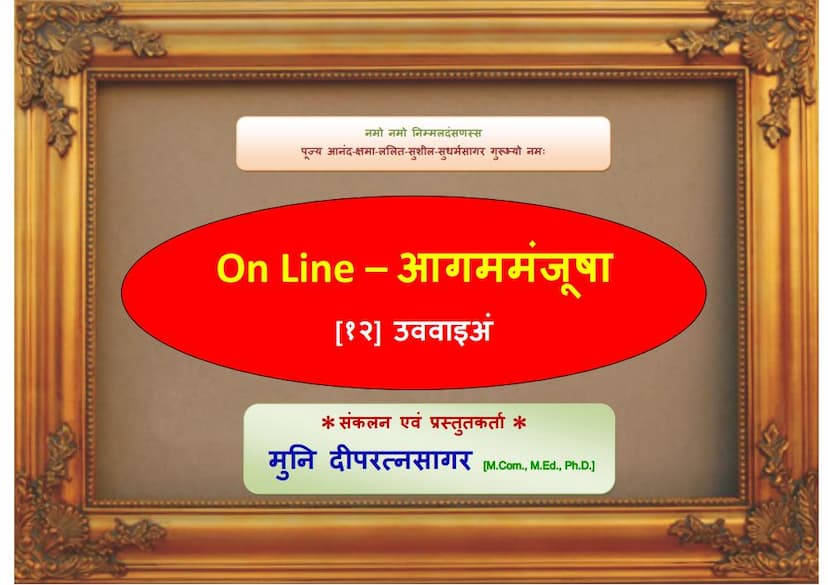Aagam Manjusha 12 Uvangsuttam Mool 01 Uvavaaiam
Added to library: September 1, 2025

Summary
This document is a Jain text titled "Aagam Manjusha 12 Uvangsuttam Mool 01 Uvavaaiam," compiled and presented by Muni Deepratnasagar. It appears to be an online version of a compilation that was originally edited by Acharya Shri Anandasagarsuri around 70 years prior to 2012 (in 1942 AD). The presented online version includes some modifications and additions to the original text.
The core of the document, starting from page 3, is the description of the city of Champa (चंपा नगरी) and its surroundings. It details the city's grandeur, including its well-laid out streets, markets, gardens, buildings, and fortifications. The text then describes a significant sacred place named Pushpabhadra Chaitya (पुष्णभद्दे नामं चेइए) located to the north-east of Champa. The description of the Chaitya is very elaborate, mentioning its adornments, fragrance, and the presence of various trees and flowers.
Following the description of the Chaitya, the text describes a large forest (वनसंडे) surrounding it, with detailed descriptions of various trees, flowers, and the sounds of birds.
The narrative then introduces King Kuniya (कृणिए णामं राया) of Champa, describing his royal lineage, virtues, wealth, and the prosperity of his kingdom. It also introduces Queen Dharini (धारिणी नामं देवी), the King's wife, and their happy married life.
The text then shifts to the arrival of Bhagavan Mahavir (समणे भगवं महावीरे), the 24th Tirthankar, who is described in great detail, emphasizing his spiritual accomplishments, physical attributes, and the vast retinue of monks, nuns, laymen, and deities that accompany him.
The narrative then describes the grand procession (समोसरणं) of Bhagavan Mahavir to the Pushpabhadra Chaitya. This section is exceptionally detailed, recounting the preparations made by the king, queen, and the entire city to welcome the Tirthankar. It includes the decoration of the city, the arrival of various deities from different realms (Asura Kumaras, Bhavanavasis, Vanavasis, Jyotishikas, Vaimanikas), and the elaborate rituals performed by them.
Bhagavan Mahavir then delivers a discourse (धम्मदेसना) to the assembled multitude. The discourse covers various aspects of Jain philosophy, including the nature of the soul, karma, liberation, the path of righteousness, and the consequences of actions. It addresses different categories of beings present, such as humans, deities, and other celestial beings.
The text then delves into detailed discussions about various ascetic practices and vows undertaken by monks and nuns, including different types of fasting, austerities, and the path to spiritual purification. It elaborates on the virtues and conduct expected of mendicants and lay followers.
A significant portion of the text is dedicated to the discourse between Bhagavan Mahavir and his chief disciple, Indrabhuti Gautam (इंदभूई नाम अणगारे). This section features philosophical questions and answers concerning the soul, karma, reincarnation, the nature of heavenly beings, the different states of existence, and the ultimate goal of liberation (Siddhi). The dialogue highlights the profound spiritual knowledge possessed by Bhagavan Mahavir and the process of spiritual realization through ascetic practices and understanding the Jain doctrines.
The text concludes with the teachings on the path to liberation, the nature of Siddhas (liberated souls), their eternal dwelling place in the Siddhashila (सिद्धाशिला), and the ultimate bliss they experience. It also discusses the different stages and types of spiritual attainment and the characteristics of liberated beings.
In essence, "Uvavaaiam" (औपपातिक सूत्र) as presented here is a comprehensive Jain scripture detailing the auspicious occasion of Bhagavan Mahavir's Samavasarana (divine sermon assembly) in Champa, the description of the sermon itself covering various philosophical and ethical aspects of Jainism, and the subsequent spiritual journeys and attainments of individuals from different walks of life. It emphasizes the importance of right faith, knowledge, and conduct for achieving liberation from the cycle of birth and death.